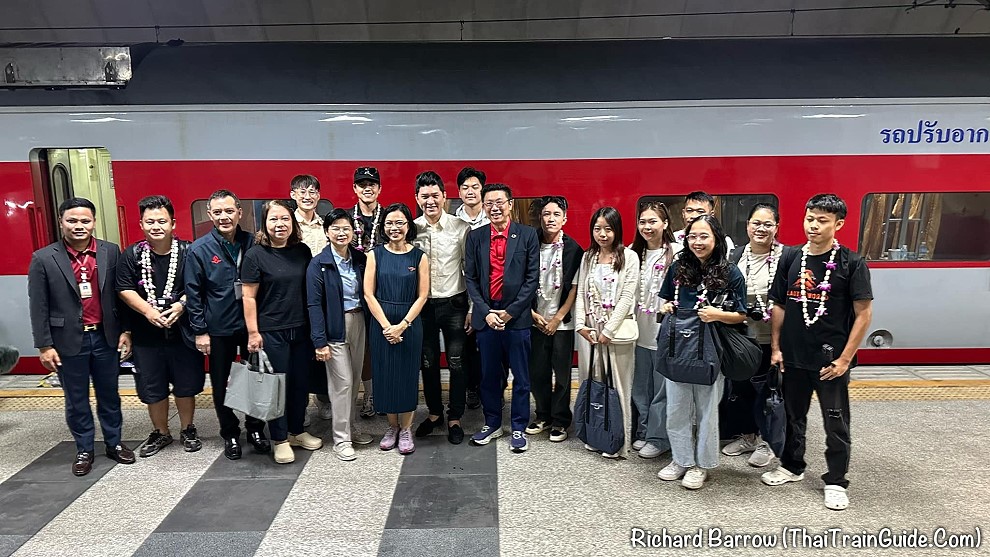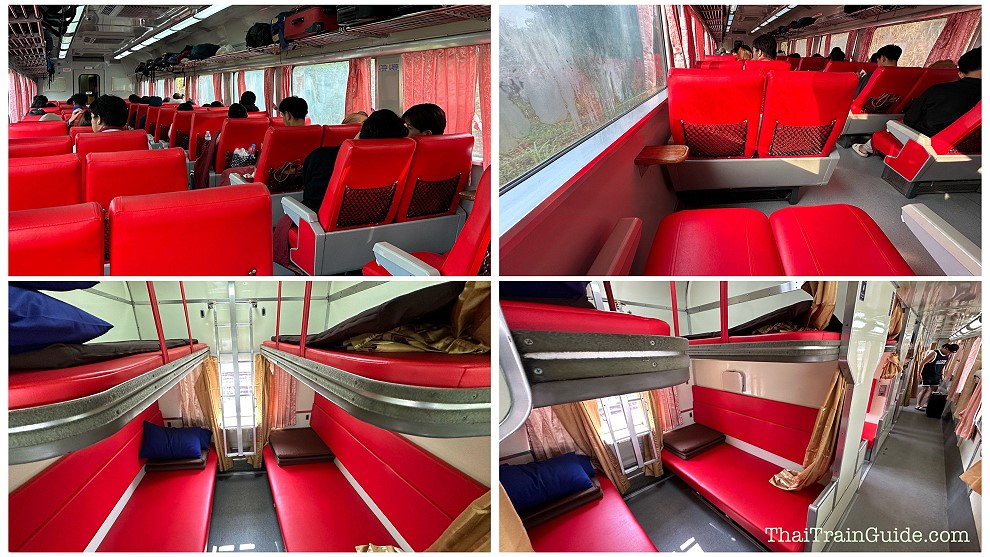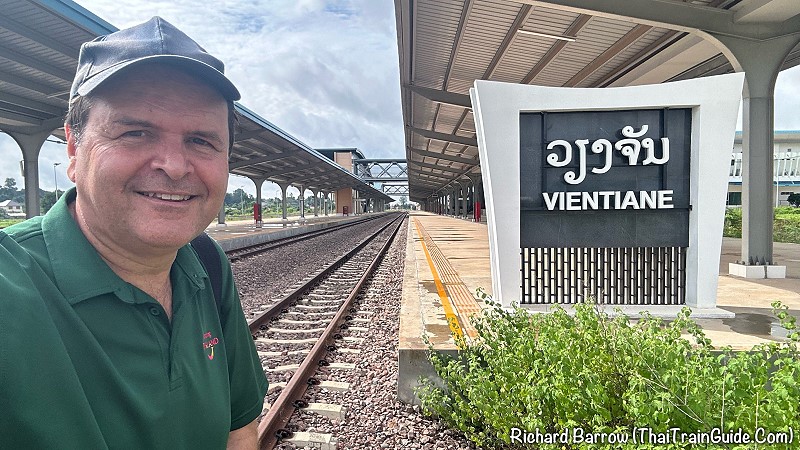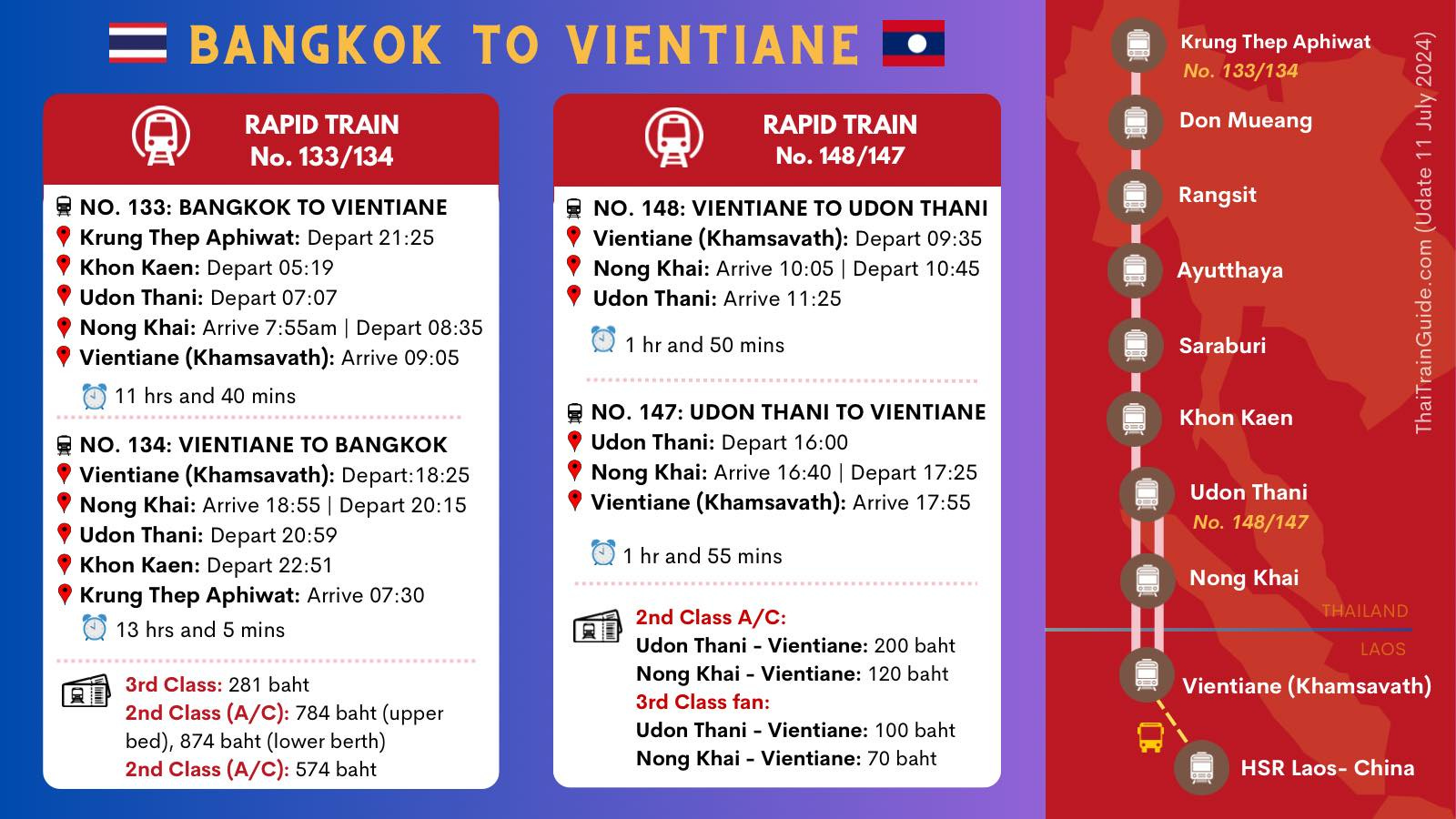Guide to the Bangkok-Vientiane Train
Welcome to the very first edition of the Asian Train Guide newsletter. My aim is to deliver a wrap-up of rail tourism news for Southeast Asia and beyond directly to your inbox. Sometimes, it will be a summary of news you may have missed. Other times, like today, it will be a complete guide on everything I know about a particular train or route. Today, we’re focusing on the first international train between Bangkok and Vientiane. Hopefully, another newsletter this year will provide a complete guide to the Bangkok to Phnom Penh train!
Starting from Friday, 19th July 2024, Rapid No. 133 (Bangkok – Nong Khai) will have a change of destination. It will become the second long-distance train in Thailand to cross a border when its destination is extended to Vientiane (Khamsavath) in Laos.
Here is everything we know so far about the changes:
- The current shuttle train across the border, No. 481/482 and No. 483/484, will cease operations on 20th July.
- There will now be two new trains crossing the border. The first one is Rapid No. 133 from Bangkok (departing Nong Khai at 8:35 a.m.) and the second one is Rapid No. 147 from Udon Thani (departing Nong Khai at 5:25 p.m.).
- The journey time between Nong Khai Station and Vientiane (Khamsavath) Station is 30 minutes.
- The trains will no longer stop for Immigration at Thanaleng Station. Instead, they will continue for another 7.5 kilometers to the new station on the outskirts of Vientiane.
- Rapid No. 133/134 will be hauled by a QSY “Ultraman” diesel-electric locomotive between Bangkok and Nong Khai. It will then cross the border hauled by an Alsthom diesel locomotive. This is apparently for two reasons: the Ultraman is too heavy for the Friendship Bridge, and the Laotian drivers, who will take over at Thanaleng Station, have only been trained on the Alsthom locomotive.

TRAIN SCHEDULE FOR RAPID NO. 133
Let’s take a look at the overnight long-distance train first. This is Rapid No. 133. The train will depart from Krung Thep Aphiwat Station in Bangkok at 9:25 p.m. It will then stop in Khon Kaen (5:19 a.m.), Udon Thani (7:07 a.m.), and Nong Khai (7:55 a.m.). Passengers who are planning to cross the border will have 40 minutes to pass through immigration. This is done on the platform and shouldn’t take too long. During this time, there will be some shunting as not all carriages will be crossing the border. The train will then depart at 8:35 a.m.
The journey across the Friendship Bridge to Vientiane (Khamsavath) Station takes about 30 minutes. The train is scheduled to arrive there at 9:05 a.m. Laos is in the same time zone as Thailand, so there is no need to adjust your watches. Lao immigration is then done on the platform. You cannot use an e-visa at this station. However, you can apply for a visa on arrival—at least I can. You should double-check the requirements for your own nationality. Last time I crossed the border, it was $40. Once you have finished these formalities, you can check out the rest of the station.

COST OF TICKETS
Until now, Rapid No. 133 only had 2nd and 3rd Class carriages with seats and fans. However, from 19th July onwards, an additional five carriages will be added. Only these carriages will cross the border. There will be two 3rd Class carriages with seats and fans, one 2nd Class carriage with seats and A/C, and two carriages with sleeper berths.
Tickets can be bought online at D-Ticket and at your local railway station. The cheapest seat is 3rd Class, which is only 281 baht. Next are the red seats with A/C, priced at 574 baht. Finally, the sleeper carriages are 874 baht for the lower berth and 784 baht for the upper berth. There are no 1st Class cabins on this train. If you want one, you should catch Special Express No. 25. This train arrives in Nong Khai about 90 minutes ahead of No. 133, allowing you to spend the night in 1st Class and then switch to No. 133 to cross the border.
FOREIGN EXCHANGE AND BUSES AT VIENTIANE STATION
There is no foreign exchange at Vientiane Station, so make sure to bring some Thai baht and US dollars. You can use these until you can change money in town. There is a shuttle bus from the new station to the bus terminal at the Morning Market. According to photos posted on social media, buses depart in the morning at 9:30 a.m. and 9:40 a.m. The cost is 20,000 kip for adults and 10,000 kip for children, and it only takes 30 minutes to reach the city.
There are also shared and private taxis as well as minivans, which will go to more places such as the Laos-China High-Speed Station. Incidentally, there is also a ticket office for the high-speed trains at this station.
RAPID NO. 148 TO UDON THANI
The first train to leave Vientiane Station for the journey back to Thailand is Rapid No. 148 (Vientiane – Udon Thani). This departs at 9:35 a.m. and stops in Nong Khai and Udon Thani. You should aim to be at the station an hour before departure to go through immigration. The bus from the Morning Market departs at 7:50 a.m. and arrives at the station at 8:20 a.m. The next bus departs at 8:20 a.m. and arrives at the station at 8:50 a.m. In theory, you should have time to pass through immigration.
Rapid No. 148 uses the same carriages as Rapid No. 133 that had just arrived from Bangkok 30 minutes earlier. So, there will be two 3rd Class carriages with seats and fans, one 2nd Class carriage with seats and A/C, and two sleeper carriages. The train will depart from Vientiane at 9:35 a.m. and will arrive in Nong Khai at 10:05 a.m., where you have 40 minutes to pass through immigration. It will then depart from Nong Khai at 10:45 a.m. and arrive in Udon Thani at 11:25 a.m.
If you are only traveling as far as Nong Khai, tickets are 70 baht for 3rd Class and 120 baht for 2nd Class. The sleeper carriage is the same price. If you are going all the way to Udon Thani, the cost is 100 baht and 200 baht respectively. You can buy these tickets online or at the station.
RAPID NO. 147 TO VIENTIANE
The return journey back to Vientiane is done by Rapid No. 147. Again it uses the same carriages. This train departs from Udon Thani at 4:00 p.m. and arrives in Nong Khai at 4:40 p.m. You have 45 minutes for immigration. The train will then depart from Nong Khai at 5:25 p.m. and arrive in Vientiane at 5:55 p.m. After you go through immigration, there are two shuttle buses into the city, which leave at 6:30 p.m. and 6:45 p.m. Train ticket prices are the same as the outbound journey.
RAPID NO. 134 TO BANGKOK
The second and final train to leave from Vientiane Station is Rapid No. 134, which makes the return journey all the way back to Bangkok. The turnaround for this train is again only 30 minutes. The shuttle bus from the Morning Market departs at 3:30 p.m. and arrives at the station at 4:00 p.m. The second one departs at 3:45 p.m. and arrives at the station at 4:15 p.m. The train back to Bangkok departs at 6:25 p.m., so there is plenty of time to catch either of these buses and then pass through immigration.
The train will arrive in Nong Khai at 6:55 p.m. This time, there is one hour and twenty minutes before departure, providing plenty of time for immigration and to get something to eat. I am presuming it takes this long because they will clean the train here. I will confirm details like this when I go on the first train next week.
If you want to return to Bangkok in a 1st Class cabin, you can switch in Nong Khai to Special Express No. 26. This departs from Nong Khai at 7:40 p.m. Rapid No. 134 will follow behind it at 8:15 p.m. with stops in Udon Thani (8:59 p.m.), Nong Khai (10:51 p.m.), and arrival back in Bangkok at 7:30 a.m. Ticket prices are the same as the outbound trip.
I will be on the inaugural train on 19th July and will be posting live on my social media channels linked below. I will also send out a summary of the trip in the next newsletter, so make sure you subscribe now. Like my train guides, it is 100% free.
If you want to help support my trips, you can Buy Me a Coffee or become a Patreon. If you ever use 12Go to book transportation tickets, please use this link https://thaitrainguide.12go.asia/en. It doesn’t cost you any more, but I get a small commission. This then gives me a budget to buy train tickets and book hotels for my research trips.
SOCIAL MEDIA:
- Twitter/X: https://twitter.com/ThaiTrainGuide
- Facebook: https://www.facebook.com/thaitrainguide/
- Asian Train Guide Facebook Group: https://www.facebook.com/groups/asiantrainguide
Thanks and I will see you in the next newsletter.
Richard Barrow






It’s a lovely idea but shame only overnight service. So you miss all the scenery along the way in exchange for a sleepless night
You can take the day train but you would need to stay overnight in Nong Khai before taking the border train.
Hola Richard gracias por tu artículo. Para hacer el visado on arrival, basta con 1 foto de carnet y el pasaporte? Muchas gracias!
Thanks for the review. Do you know whether it is possible to bring a bicycle on the route from Vientiane to Bangkok? Or maybe only from Nong Khai to Bangkok?
There is no cargo carriage crossing the border. But a folding bike should be fine.
Dear Richard, I am trying to book a 2nd class AC lower berth on train #25 from Ayuttaya to Nong Khai but it seems that 12goAsia goes direct to payment instructions showing no options regarding berth/seat. Is there any way to book the berth I wish? I’m booking from Italy quote in advance. Many thanks for your info and really helpful web site and Fb pages.
You need to use the official D-Ticket site to choose a berth. But not everyone can access it from abroad.
Dear Richard
Do you know if this train still has cargo carriages like it used to before it continued until Vientiane?
Yes it does but it doesn’t cross the border.